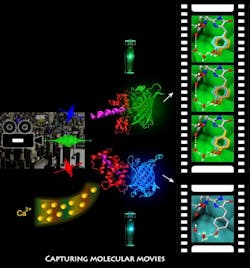Femtosecond laser-driven imaging approach promising for bioimaging, biomedicine
Researchers from Oregon State University (OSU; Corvallis, OR) and the University of Alberta (Edmonton, AB, Canada) have developed an imaging technology that is fast enough to observe life processes as they actually happen at the molecular level. The technology, which uses femtosecond pulsed lasers and green fluorescent proteins (GFPs), can measure chemical and biological actions one frame at a time, which could lead to improved biosensors to study nerve impulses and cancer metastasis as it occurs, among others.
Related: Ultrafast pulses for precision procedures
"With this technology, we're going to be able to slow down the observation of living processes and understand the exact sequences of biochemical reactions," says Chong Fang, an assistant professor of chemistry in the OSU College of Science who is leading the research. "We believe this is the first time ever that you can really see chemistry in action inside a biosensor," he says.
The speed of the researchers' new approach will allow scientists to "see" what is happening at the molecular level and create whatever kind of sensor they want by rational design. This will improve the study of, for example, cell metabolism to nerve impulses, how a flu virus infects a person, or how a malignant tumor spreads.
The technology, for instance, can follow the proton transfer associated with the movement of calcium ions—one of the most basic aspects of almost all living systems, and also one of the fastest. This movement of protons is integral to everything from respiration to cell metabolism and even plant photosynthesis. Scientists will now be able to identify what is going on, one step at a time, and then use that knowledge to create customized biosensors for improved imaging of life processes.
"If you think of this in photographic terms," Fang explains, "we now have a camera fast enough to capture the molecular dance of life. We're making molecular movies. And with this, we’re going to be able to create sensors that answer some important, new questions in biophysics, biochemistry, materials science, and biomedical problems."
The team's findings have been published in the Proceedings of the National Academy of Sciences; for more information, please visit http://dx.doi.org/10.1073/pnas.1403712111.
-----
Don't miss Strategies in Biophotonics, a conference and exhibition dedicated to development and commercialization of bio-optics and biophotonics technologies!
Follow us on Twitter, 'like' us on Facebook, and join our group on LinkedIn
Subscribe now to BioOptics World magazine; it's free!
BioOptics World Editors
We edited the content of this article, which was contributed by outside sources, to fit our style and substance requirements. (Editor’s Note: BioOptics World has folded as a brand and is now part of Laser Focus World, effective in 2022.)
